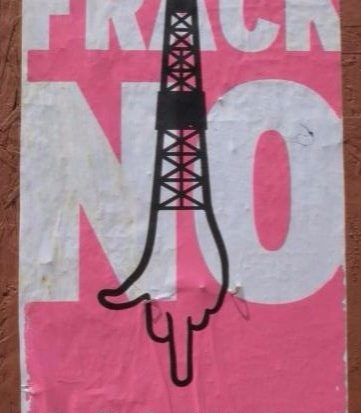
By Gary Lasky
Fresno County is targeted for fracking—a form of oil and gas extraction in which fluids are pumped underground with sand and, frequently, toxic chemicals to release oil reserves.
Released in January, the film Promised Land features Matt Damon as a gas company huckster who sells fracking to a fictional small town in Pennsylvania. In real life, as in the film, a gold-rush mind-set prevails in northern Pennsylvania. Cash-starved farmers in a depressed economy see potential for a huge windfall from leasing their land for fracking to Oklahoma-based Chesapeake Gas.
With oil prices holding steady at around $100 a barrel, new drilling technologies have rapidly spread. We have seen huge activity in Ohio, as well as Pennsylvania, Texas, North Dakota and Colorado. Sources friendly to the oil industry reassure us that, in California, fracking has been in place for 40 years with no contamination of water supplies.
Well-informed opponents beg to differ. “Fracking for oil and gas is inherently a dirty and dangerous process that decimates entire landscapes,” said Michael Brune, executive director of the Sierra Club, based in San Francisco.
Fracking Arrives in the Valley
We are now prepared for fracking in Central California, where the Monterey Shale formation holds an estimated 20 billion barrels of oil. An unknown amount is recoverable. The formation runs from Kern County, north to Stanislaus County, west to Monterey County and south to Santa Maria.
Fracking activists (fracktivists!) have been preparing for its arrival in California. We have learned lessons from activist friends in New York and Pennsylvania, Texas, Colorado and North Dakota. And we are not going to let fracking steamroll California without a fight.
Environmental Impacts
These are guaranteed damaging impacts to the environment and human health from fracking:
- Water supply issues (250,000-plus gallons per frack, gone forever)
- Fracking toxic brine waste disposal
- Groundwater contamination from fracking waste
- Air pollution from diesel generators and trucks
- Truck traffic to and from fracking site
- Climate change
Today, scientists have demonstrated that natural gas is at least as bad—likely worse—than either coal or oil for global warming due to the release of greenhouse gases into the atmosphere. How could this be? Because natural gas is a euphemism for methane. And methane is a far more potent contributor to the warming of the planet than is carbon dioxide: 72 times as potent as CO2 at trapping heat in the atmosphere.
Methane can leak into the atmosphere at any point along its life cycle—at the wellhead, in storage, in transport and in pipes before it is delivered to homes and industry. If just 4% of methane leaks into the atmosphere in the drilling, storage and distribution phases, then natural gas is as destructive to atmospheric heating as CO2. Estimates of 6%–8% appear likely.
Court Victory
On Sept. 14, 2011, the federal Bureau of Land Management (BLM) held an oil lease sale in which mineral rights were leased on approximately 2,700 acres of federal land, mostly in far southern Monterey County. Included in this sale were six 40-acre parcels in west Fresno County, five miles southeast of Coalinga.
The national Sierra Club and the Center for Biological Diversity filed suit in federal district court, arguing that the environmental review did not include an Environmental Impact Statement and did not comply with the National Environmental Policy Act (NEPA).
On March 31, 2013, in San Jose, Magistrate Judge Paul Grewal ruled in favor of environmentalists in Center for Biological Diversity and Sierra Club v. Bureau of Land Management.
In a decision with national implications, Judge Grewal held that the BLM violated the NEPA in preparing its Environmental Assessment (EA) for this oil and gas lease sale. The EA relied on a 2006 scenario that did not adequately consider the environmental impacts of horizontal fracking. The BLM’s finding of “No Significant Impact” was “erroneous as a matter of law” because the analysis failed to take into account all “reasonably foreseeable” possibilities from drilling, as required by the NEPA.
Legislative Action
Last weekend, the California Democratic Party defied all expectations at its 2013 convention and passed a strong resolution calling for a moratorium on fracking in California. Activists from across the state realized that we are at a crossroads where action is vital.
Now, our legislative allies in the state legislature in Sacramento are making a serious commitment as well. Ten bills are still alive this legislative session, and we have until the end of April to get them out of committees. These include bills to regulate fracking waste, monitor groundwater quality, increase bond monies required, require prior approval by the Regional Water Board, require notification of neighbors and require disclosure of fracking fluids used.
In addition, three moratorium bills have been introduced.
Action Is Needed Now
We are working with our statewide network of fracktivists and Food and Water Watch to get a conditions-based moratorium on fracking. This activism culminated in two bills in the California Assembly calling for a moratorium on fracking in California—AB 1301 authored by Assembly Member Richard Bloom (D–Santa Monica) and AB 1323 authored by Assembly Member Holly Mitchell (D–Los Angeles). These bills are being considered by the Natural Resources Committee and are scheduled for a vote by the committee on April 29.
The tide is turning. Please contact the author if you are interested in traveling to Sacramento to speak with legislators and meet our statewide fracktivist network on April 29.
*****
Gary Lasky is a fractivist and the conservation chair of the Sierra Club Tehipite Chapter in Fresno. Contact him at data.nations@gmail.com or 559-790-3495.
